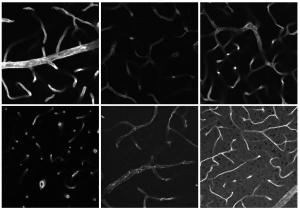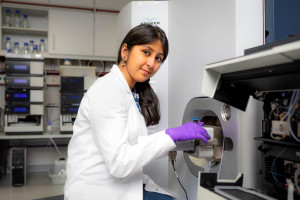Dortmund, 21st December 2023
Psychologist Leon Windscheid sells 100,000 tickets for his stage performance "Gute Gefühle" (Good Feelings), science programmes presented by physician Eckart von Hirschhausen have been on prime time television for years, and videos by chemist Mai Thi Nguyen-Kim were at times the most clicked on YouTube. All of the people mentioned prove that science does not have to be complicated and therefore dry. When done well, science communication is pure entertainment. Four ISAS employees wanted to demonstrate this and took to the stage for the institute's own science slam in December.
"Science slam means science communication!" - Cheyenne Peters opened the event at ISAS Campus with these words. The science editor had already organised the kick-off meeting for the science slam in October of this year, and had begun training the researchers shortly afterwards. "How do I communicate science? How do I develop a story? I want to show young scientists in particular ways in which they can present their research in an unconventional, relaxed and for laypeople understandable way ", says Peters.
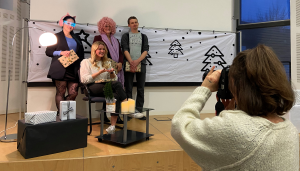
The four participants shared the proud moment after their slams for a photo with Luisa Becher, author of this article and intern in the Communications team at ISAS.
© ISAS
Good science succeeds through teamwork
The participants presented themselves to the audience with creative contributions about their research or self-chosen topics. Each participant had ten minutes. Darleen Hüser was the first to take to the stage. In candlelight and with a thick book, the PhD student reminded the audience of a Christmas storyteller: one night in the lab, all the microscopes and tools such as a pipette come to life. In real life, Hüser researches molecular and cellular processes that are triggered by inflammation. To clarify her immunological questions, the biologist uses various analytical methods, such as the light sheet fluorescence microscope or the confocal microscope. With a great deal of humour and in English, the scientist rhymed about fluorophores, the Stokes shift, and the advantages of the individual microscopy techniques. Her poem, accompanied by colourful animations, quickly made it clear that the strength of each technique does not lie in their uniqueness, but in in being used together. That is why in the poem, the little pipette squeals with delight "with your strengths combined as a team, together you are a microscopic dream." In addition to her scientific message, that was exactly what Hüser wanted to convey: "Teamwork is always the key to success. We have a great deal of different expertise at ISAS, and we can utilise it in an interdisciplinary way. That is our methodological and human strength!"
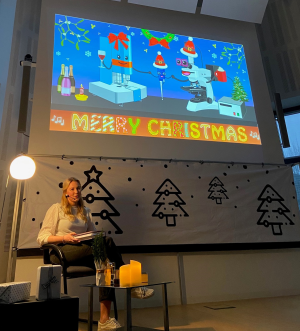
For her slam, PhD student Darleen Hüser brought microscopes and pipettes in the lab to life in a Christmas story.
© ISAS
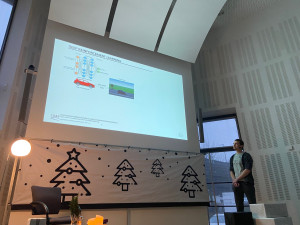
But because he is fascinated by the potential applications of artificial intelligence, his slam focussed on the pitfalls of AI using the example of his hobby: building autonomous flying drones.
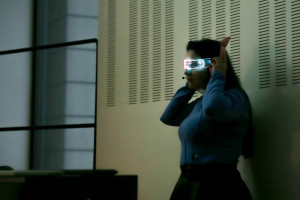
Kathrin Krieger is researching haptic gloves. As a passionate gamer, virtual reality is also an issue for the doctoral student in her private life. The bioinformatician shared her experiences and how they relate to her research with the audience.
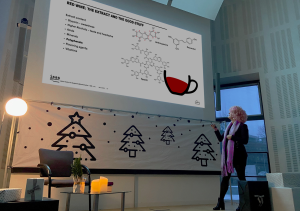
With lots of charm, humour and imagination, Luisa Röbisch dived into the world of Northpole University with the audience. The audience not only had a good laugh during her slam, but also learned a lot about the ingredients of mulled wine. The bio-laboratory technician added a dash of humour to her recommendation for consuming the hot drink.
Virtual research you can touch
Interdisciplinarity and interest in various research topics were also evident in Johann Dierks' presentation. The science slam 2023 also offered participants the opportunity to engage scientifically with a topic outside their own field of research. Dierks is passionate about artificial intelligence (AI). The physicist has already built a self-flying drone with his father. A drone crash gave him the idea for his contribution to the science slam. Among other things, Dierks addressed the question of who in the future will have to take responsibility for mistakes and accidents caused by AI.
Kathrin Krieger also confronted the audience with a computer science question: Why is virtual reality (VR) needed in a research institution like ISAS? Not to play computer games, as the gaming-enthusiastic researcher emphasised, but to make science tangible in the truest sense of the word. Krieger is working on haptic gloves. These VR gloves allow its wearers to touch virtual objects - and thus grasp them. "I think science communication is extremely important. On the one hand, to familiarise people with a scientific topic and allow them to participate in the culture of debate. One the other hand, to educate each other in interdisciplinary teams like the ones we have here at ISAS", said Krieger. The scientist then used numerous interactions and props to encourage the audience to test their own visual perception. At the same time, she showed the audience the advantages of haptic gloves. For example, researchers could one day touch 3D-computer models of their microscopic images using haptic gloves. In the future, doctors could prepare for operations by examining tissue or organs in the virtual world, for example.
"Science is in the everyday"
Luisa Röbisch's presentation was also a plea for more networking and more communication. The technical assistant was inspired by her hobby of theatre acting and was motivated to give a comic presentation. ISAS became Northpole University, the employees turned into busy elves and Röbisch herself became Dr Dr rer. chris. Eugenia F. Stardust. With bouncing pink curls and glistening cheeks, Stardust explained the chemical composition of mulled wine. "Science is in the everyday. All you have to do is observe the world around you with curiosity," commented Röbisch on her choice of topic. A positive side effect of the presented hot drink, which is full of plant-based secondary metabolites, is that drinking it makes communication easier. With a wink and an appeal to savour a Christmassy wine or two, the biotechnologist dismissed the audience for the vote.
99.4 decibels for the win
At the end of the science slam, it was up to the audience to choose a winner. A decibel meter was used to determine the loudest applause per slam. Only a few decibels, barely perceptible to the ear, made the difference. Darleen Hüser won the ISAS Science Slam 2023 with her elaborate poem and lovingly crafted presentation. The smiling winner immediately had a plan for another science slam: "Next time, it's our principal investigators’ turn."
(Luisa Becher)
Luisa Becher (30), a microbiologist from the Rhineland, realised after completing her Master's degree that she preferred to report on many different areas of research. This is why she is now studying science journalism at TU Dortmund University. She took her first steps in journalism at Radio Bonn/Rhein Sieg and WDR. As an intern in the Communications team at ISAS, she is now getting an idea of how press and public relations work at one of the Leibniz institutes.
